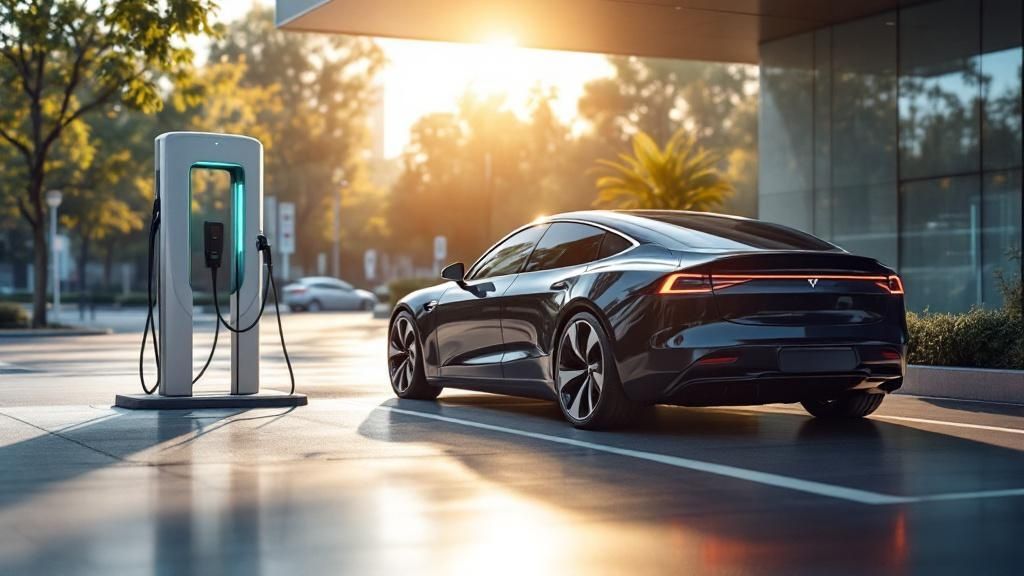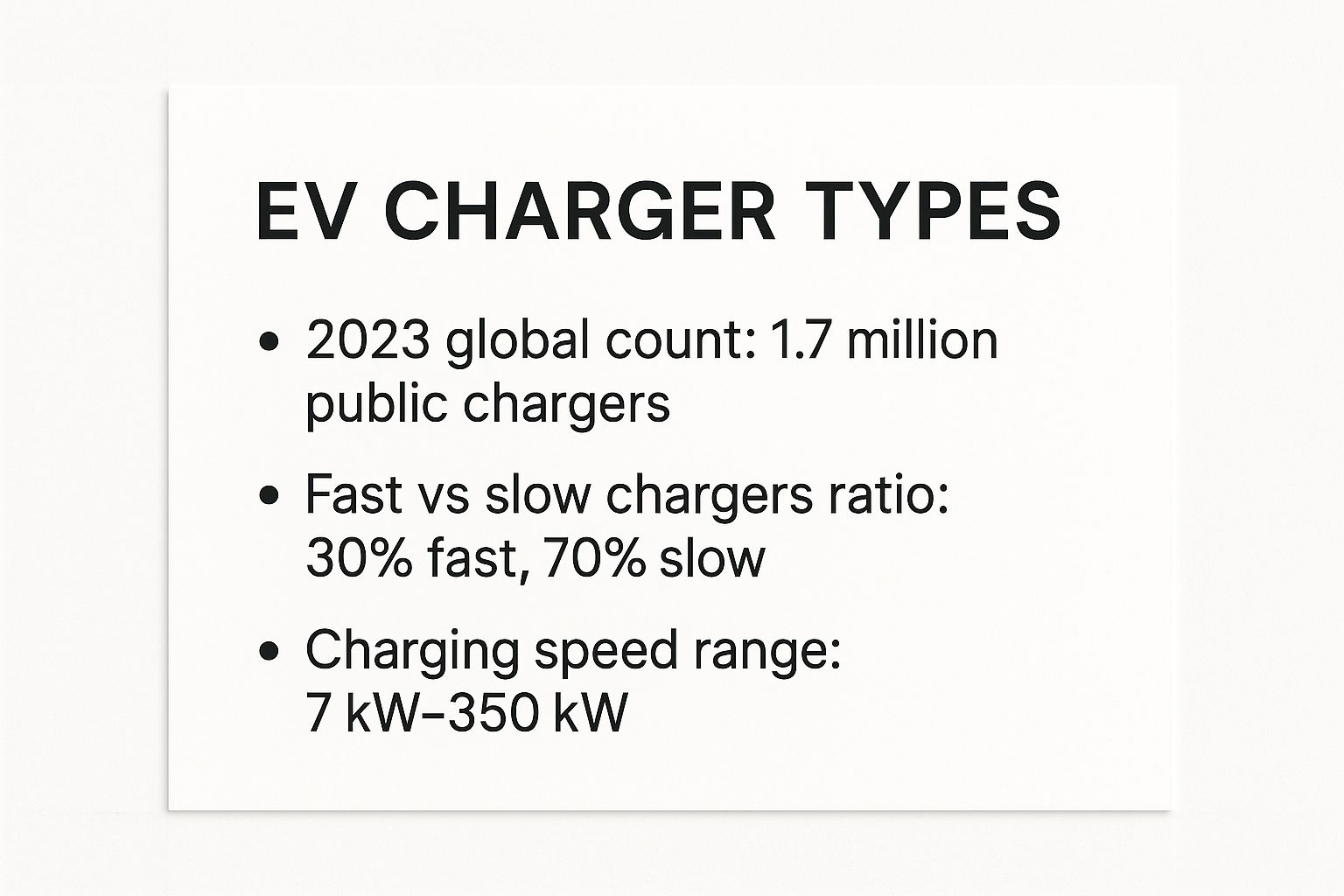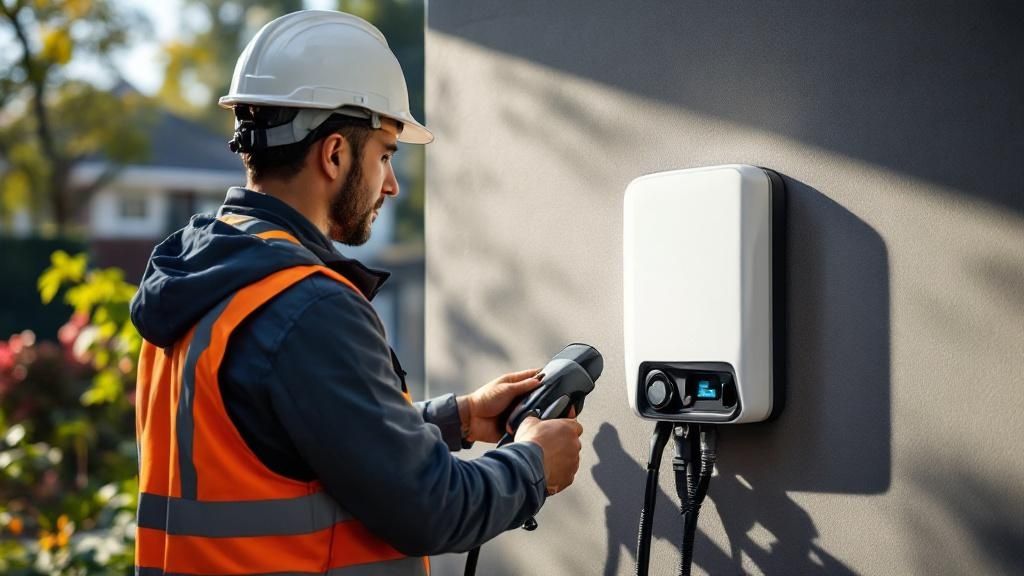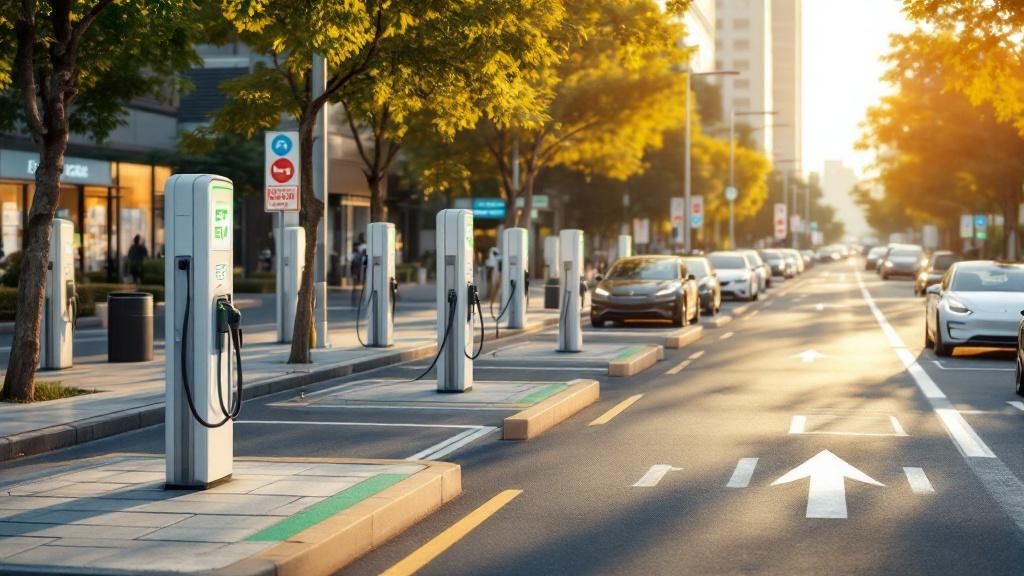Welcome to the backbone of the electric vehicle revolution. When you think of electric vehicle charging infrastructure, don't just picture a simple wall outlet. Instead, imagine the vast, sophisticated network of gas stations that has powered our world for a century. This is the essential system that makes driving an EV practical, reliable, and convenient for everyone.
The Foundation of Modern Mobility
As more and more people switch to EVs, building out a robust and accessible charging network has become a global priority. This is about more than just plugging in a car; it's about engineering an entire ecosystem to support a cleaner transportation future. From a single charger in a home garage to sprawling public networks lining our highways, this infrastructure is what will unlock the true potential of electric mobility.

Think of this guide as your roadmap. We’ll walk through everything you need to know about EV charging, from the different types of chargers and the nitty-gritty of installation to the economics of running a charging business and the smart tech that keeps it all humming.
A Rapidly Expanding Network
The growth we're seeing is staggering. Globally, the number of public charge points shot up to over 5 million between 2022 and 2024—more than doubling in just two years. While China accounts for a huge part of that expansion, the United States has also seen a significant 20% jump, hitting nearly 200,000 public charge points by 2024. This shows a serious commitment to making the EV transition a reality. You can find more insights on the global EV market over at Virta.global.
A well-developed electric vehicle charging infrastructure provides "range confidence," eliminating the anxiety drivers might feel about finding their next charge. It transforms the EV from a city-centric vehicle into one capable of long-distance travel with ease.
This boom is fueled by a mix of government investment and private innovation, all pushing toward a single goal: making it as easy to charge an EV as it is to fill up a gas tank. At its core, this growing network is built on a few key components:
- Hardware: These are the physical charging stations themselves, from the slow-and-steady Level 1 units to the powerhouse DC fast chargers.
- Software: This is the brain of the operation—the network management systems that process payments, monitor station health, and give drivers real-time info.
- The Electrical Grid: All that power has to come from somewhere. The underlying grid needs to be ready to handle the increased demand from millions of EVs.
- Policy and Incentives: These are the government programs and rebates that make it attractive for businesses and individuals to invest in and install new charging stations.
Decoding the Different EV Charger Levels
When we talk about electric vehicle charging infrastructure, it's important to know that not all chargers are created equal. Think of them like different types of fuel pumps—some are designed for a slow, steady top-up overnight, while others deliver a massive surge of power for long-distance travel. Each type, or "level," plays a unique role in the EV ecosystem.
The real difference between them comes down to power output. This is what determines how quickly you can add range to your car's battery. A lower-level charger sips power into your car, while a high-powered one is like a fire hose, filling it up in a fraction of the time.
Let's break down the three main tiers you'll run into.
Level 1 Charging: The Convenient Trickle
Level 1 charging is the simplest and most accessible option out there. It uses a standard 120-volt household outlet—the same one you plug your phone or laptop into. That’s its biggest advantage: you don’t need any special installation.
But that convenience comes with a trade-off: speed. Level 1 is often called "trickle charging" because it only adds about 2 to 5 miles of range per hour. It's not going to save you if you're in a hurry, but it’s perfect for drivers who can plug in their car overnight and wake up to a full battery.
It’s a great fit for homeowners with short daily commutes, but you won’t find it in public or commercial settings where people need to charge up and go.
Level 2 Charging: The Everyday Workhorse
Level 2 is the sweet spot for most drivers and makes up the backbone of public charging. These chargers run on a 240-volt circuit, similar to what you’d use for an electric stove or dryer, and they do require professional installation.
They pack a much bigger punch, adding anywhere from 10 to 60 miles of range per hour. This makes them incredibly versatile and the true workhorse of the EV world. You’ll find them everywhere:
- Home Garages: Easily charges a car from empty to full overnight.
- Workplace Parking: Lets employees top up their batteries during the workday.
- Public Hotspots: Found at shopping malls, restaurants, and hotels, giving you a solid boost while you're busy.
Getting a Level 2 station set up costs more, with hardware and installation typically running between $1,500 and $10,000. Despite the upfront cost, their perfect balance of speed and affordability makes them essential. And of course, keeping your battery healthy is just as important as keeping it charged; check out these tips for electric vehicle maintenance.
The widespread availability of Level 2 chargers is the key to crushing range anxiety for daily drivers. When you know you can grab a significant charge while at work or running errands, driving an EV just feels easy.
To give you a clearer picture, here's a quick comparison of the different charger levels and what they're best used for.
EV Charger Levels at a Glance
| Charger Type | Power Output | Charging Speed (Miles of Range per Hour) | Common Locations | Best For |
|---|---|---|---|---|
| Level 1 | 1.4 kW – 1.9 kW | 2 – 5 miles | Home garages, workplaces (limited) | Overnight charging for short-commute drivers. |
| Level 2 | 3 kW – 19.2 kW | 10 – 60 miles | Homes, workplaces, public lots, retail | All-purpose daily charging at home or destinations. |
| DC Fast | 50 kW – 350+ kW | 100 – 200+ miles in 20-30 mins | Highway corridors, dedicated charging hubs | Rapid refueling during long-distance road trips. |
As you can see, each level is designed for a specific situation, from a slow overnight charge at home to a lightning-fast pit stop on the highway.

DC Fast Charging: The Highway Game-Changer
DC Fast Charging, sometimes called Level 3, is the undisputed king of speed. While Level 1 and 2 chargers use the Alternating Current (AC) from the power grid, these stations have a built-in converter that supplies Direct Current (DC) straight to the battery.
By bypassing the car's own onboard converter, these chargers can deliver mind-blowing speeds. We're talking about adding 100 to 200+ miles of range in just 20 to 30 minutes. These are the chargers you see along major highways, designed to make an EV road trip just as practical as one in a gas-powered car.
This kind of power doesn't come cheap. A single DC fast charger can cost anywhere from $40,000 to over $100,000 to install, thanks to the sophisticated hardware and the need for a serious high-voltage connection to the grid. Still, this investment is absolutely critical for building a robust charging network that gives drivers the freedom to go anywhere.
A Practical Guide to Installing Charging Stations
Alright, so you understand the different types of chargers. Now comes the exciting part: actually putting them in the ground. For any business, property manager, or city planner, adding your own electric vehicle charging infrastructure is more than just an amenity—it turns your location into a destination. But getting there takes some real planning, and it all starts with a hard look at your site.
First things first, you need to do a detailed site assessment. Put yourself in the driver's seat. Is the spot easy to find? Is it visible and simple to get to? You'll want to target areas near building entrances, in well-lit parts of your lot, or along routes people already use. Just as important is how close you are to a good power source. This one factor can make or break your budget, as a long run from an electrical panel means more complex—and expensive—work.
Evaluating Power Requirements and Site Readiness
Once you’ve picked out a few potential spots, it's time to talk power. It's one thing to support a single Level 2 charger, but it's a completely different ballgame if you're planning for a bank of DC fast chargers. Those high-speed units are power-hungry and often demand a dedicated high-voltage supply and serious upgrades to your building's electrical system.
To figure out what you really need, ask yourself these questions:
- Who is this for? Employees who can charge all day have very different needs than a customer who needs a quick boost while they shop.
- How many cars at once? This directly impacts how many chargers you'll need and the total electrical load you have to plan for.
- What's the budget for electrical work? A Level 2 station might run you up to $10,000 once installed, while a single DC fast charger can easily rocket past $100,000.
A proper electrical assessment isn't optional; it's essential. Getting a certified electrician involved from the very beginning will save you from sticker shock later on and ensure your site can handle the new demand without tripping the breakers on your existing operations.
This initial assessment will tell you if you're looking at a simple hook-up or a project that needs some serious groundwork. For many installations, a critical part of the job is the underground utility trenching for electrical lines needed to get power to the station safely and reliably.

Navigating the Installation Process
With a solid plan in hand, the installation itself is a series of well-coordinated steps. This isn't just about bolting a charger to the wall; it’s a small construction project that demands professional oversight and a close eye on regulations.
Here's what the typical workflow looks like:
- Permitting and Compliance: Before a single shovel hits the dirt, you need the green light from your local authorities. This means submitting detailed plans that meet all zoning, building, and accessibility codes.
- Hiring Certified Professionals: This is a job for a qualified and licensed electrician, no exceptions. They'll handle everything from running the conduit and wiring to making the final connection at your electrical panel.
- Physical Installation: This is the hands-on part—prepping the site, mounting the charging units, and hooking up all the electrical components. For big projects with DC fast chargers, this can feel like a full-blown construction job.
- Inspection and Commissioning: Once the work is done, a final inspection from the city or county is required to make sure everything is safe and up to code. After you get the sign-off, the station is commissioned, which means it gets connected to its network and is ready for drivers to use.
For organizations running a fleet of vehicles, this installation is just one piece of a much larger operational puzzle. You need to think about how this new infrastructure fits with your daily routes and vehicle uptime. To dive deeper, you can check out our complete guide on https://solanaev.com/electric-vehicle-fleet-management/. By following these steps, you can confidently build out your own charging stations and become part of the growing network that's making electric mobility a reality.
The Real Cost of EV Charging
When you're thinking about installing electric vehicle charging infrastructure, it's easy to focus on the price of the charger itself. But that's just the tip of the iceberg. This is a serious financial decision, and getting a clear picture of the full economic story—from day-one costs to long-term profits—is the only way to know if your project will actually pay off.
The true financial equation is a mix of upfront capital, the costs to keep things running smoothly, and the different ways you can make that money back. Let's dig into what that really looks like.

Breaking Down the Initial Investment
The upfront cost is the first big hill to climb. It's a blend of equipment, skilled labor, and the not-so-fun administrative work, and each piece adds a significant chunk to the final bill. Smart planning helps, but you have to account for every single element right from the start.
Here’s a realistic look at the main costs you’ll be facing:
- Hardware and Software: This is the charging station itself (the EVSE) plus the networking software that makes everything tick—payment processing, managing users, and running diagnostics from afar. A commercial Level 2 charger unit might run you $1,500 to $5,000, but a DC fast charger? That’s a different league, starting at $20,000 and easily soaring past $100,000.
- Installation Labor: This is a huge variable. The cost really depends on how ready your site is. Are you close to an electrical panel? Will you need to dig trenches to run conduits? Installation can easily tack on another $4,000 to $10,000+ for each station.
- Permitting and Inspections: You can't just plug these things in. You'll have to navigate local rules, pay for permits, and schedule inspections to make sure the installation is safe and up to code.
All in, the total investment for a single commercial Level 2 charger often lands somewhere between $6,000 and $15,000. For a DC fast charging station, you could be looking at a bill well over $100,000. These numbers really drive home why a thorough site assessment is non-negotiable before you commit.
The Costs Don't Stop at Installation
Once your chargers are up and running, the meter keeps ticking. These ongoing operational costs are a critical piece of the financial puzzle and will directly shape how profitable your stations are. You have to bake these into your pricing strategy to ensure the project stays in the black for years to come.
The main recurring expenses you'll see are:
- Electricity: This is the most obvious one—the cost of the energy used to charge vehicles. It’s typically based on commercial utility rates, which can fluctuate with time-of-day pricing.
- Network Fees: Think of this like a software subscription for your chargers. You'll pay monthly or annual fees to a charging network for payment processing, customer support, and software services.
- Maintenance and Repairs: Things break. Proactive maintenance and the occasional unexpected repair are essential for keeping your stations online and reliable. Understanding EV charging efficiency can also help you get a better handle on your long-term electricity costs.
Making Your Money Back (and Then Some)
The costs are only half the equation. The exciting part is turning your charging infrastructure into a business that actually generates revenue. A few different models have proven to work well, giving station owners flexible ways to monetize their investment.
You could go with simple pay-per-use billing, offer monthly subscriptions for local drivers, or even provide charging for free as a perk to draw customers to your main business, like a hotel or retail shop.
To make the deal even sweeter, governments and utilities are rolling out tons of financial incentives to get more chargers in the ground. These programs are designed to dramatically lower the upfront cost. Keep an eye out for federal tax credits, state-level grants, and local utility rebates—they can often cover a huge portion of your initial installation costs and make the numbers look much friendlier.
This global push is creating enormous opportunities. By 2023, China had already installed around 2.7 million charging stations, which is about two-thirds of all chargers in the world. The United States, by comparison, had about 183,000. That gap shows just how much room there is to grow. By combining a smart revenue plan with the right incentives, you can build an incredibly strong financial case for your project.
What's Next for EV Charging Technology?
The EV charging we have today is already impressive, but what’s just around the corner is where things get really interesting. The technology is sprinting forward, looking to solve today’s biggest pain points and create a future where charging is faster, easier, and just melts into the background of our lives. This next wave of innovation is about to completely reshape the experience of owning an EV.
The biggest obsession, of course, is speed. Today's DC fast chargers are great, but the industry is in a dead sprint toward "ultra-fast charging." We're talking about chargers that can deliver 350kW of power or even more. The end game? Make charging an EV as quick as a pit stop for gas—think adding hundreds of miles of range in less than ten minutes.
And this isn't just some far-off dream; these systems are already being built and put in the ground.
Making Charging Effortless
Picture this: you pull into your garage, and your car just starts charging. No plugs, no cables. That's the promise of wireless (inductive) charging, where an EV can recharge just by parking over a special pad. This could completely change the game for home charging, public parking lots, and even taxi queues.
Taking it a step further, some are even working on dynamic wireless charging. This would mean embedding charging tech right into the roads, letting vehicles power up as they drive. It’s the kind of idea that could make range anxiety a thing of the past. It’s all about making the act of "fueling" your car totally invisible.
The real goal for the future of EV charging is to make it so seamless that drivers barely even have to think about it. The technology should bend to fit our lives, not the other way around.
The global momentum behind this is undeniable. Projections show that by 2030, we’ll see around 12.9 million public EV chargers worldwide. That number includes an estimated 4.7 million fast chargers, a clear signal that a massive investment is being poured into these next-generation technologies. You can dig into more of the numbers on global EV charging growth to see just how big this shift is.
Smarter Grids and Greener Energy
The future isn't just faster and more convenient—it's also greener. A huge trend is tying renewable energy directly into the charging infrastructure. You're already starting to see this with solar canopies over charging station parking lots, which generate clean electricity right where it's used.
This approach creates a neat, self-sustaining loop that shrinks the carbon footprint of driving an EV even more. Plus, these solar-powered stations can send extra power back to the grid or store it in on-site batteries, helping to make the local power supply more stable.
This brings us to another breakthrough idea: Vehicle-to-Grid (V2G) technology. V2G will let EVs give power back, not just take it.
Here’s what that unlocks:
- Grid Support: During peak hours when everyone's running their AC, a whole network of plugged-in EVs could act like one giant battery, sending power to the grid to prevent brownouts.
- New Income for Drivers: EV owners could actually make money by selling the extra power in their car's battery back to the utility when demand is high.
- Balancing Renewables: V2G is perfect for managing the ups and downs of wind and solar. EVs can soak up excess renewable energy when it's sunny or windy and release it back to the grid when it's not.
This two-way energy flow turns every EV into an active player on the grid, helping build a smarter, more resilient, and more sustainable energy system for all of us.
Common Questions About EV Charging Infrastructure
As you get more familiar with the world of electric vehicle charging, a few practical questions almost always come up. The technology is moving fast, and it's easy to get tangled in the details. Let's break down some of the most common questions we hear to clear up any lingering confusion.
We'll cover everything from the real-world costs of installation to what "smart charging" actually means for you.
How Much Does Installing a Public Charger Cost?
This is the big one, and the honest answer is: it depends entirely on the power level.
A commercial Level 2 charger—the kind you’d see at a workplace, hotel, or shopping center—is the most common. The all-in cost for one of these, including installation, typically lands somewhere between $4,000 and $10,000. The final price tag can swing quite a bit based on how much work is needed to get power to the spot, like trenching or running long conduits from an electrical panel.
Then you have the heavy hitters: DC Fast Chargers. These are a whole different ballgame. You can expect a single station to cost anywhere from $40,000 to over $100,000 to install. The hardware itself is far more expensive, and these chargers require a serious electrical upgrade, often needing a three-phase power supply to handle the massive energy demand.
Station Versus Network: What Is the Difference?
It’s easy to use these terms interchangeably, but they refer to two very different pieces of the puzzle.
-
A charging station is the physical hardware you interact with. It's the box on the wall or the pedestal in the parking lot, complete with the cable and the plug that goes into your vehicle.
-
A charging network is the company running the show from behind the curtain. Think of names like EVgo or Electrify America. They manage the software, payment systems, mobile apps, and customer support that make all those individual stations work together as a seamless service.
The station is just the tool; the network is the intelligence that makes it useful.
A great way to think about it is like an ATM. The physical machine is the "station," but the banking network (like Visa or Mastercard) is what actually processes your transaction and connects everything. The same idea applies here.
Can Any EV Use Any Public Charger?
Mostly, yes—but you might need an adapter. In North America, the J1772 connector is the universal standard for Level 2 charging. Almost every non-Tesla EV uses this plug directly. Tesla drivers can also use these stations, they just need a small adapter that typically comes with their car.
Things get a little more fragmented with DC Fast Charging, where a few standards are still competing:
- CCS (Combined Charging System): The standard for most American and European automakers.
- NACS (North American Charging Standard): Tesla's connector, which is now being rapidly adopted by other major brands like Ford and GM.
- CHAdeMO: An older standard, now mostly found on vehicles like the Nissan Leaf and some Mitsubishi models.
To simplify things for drivers, most new public charging sites are now being built with both CCS and NACS plugs, covering the vast majority of EVs on the road today.
What Is Smart Charging and Why Does It Matter?
Smart charging isn't about speed; it's about intelligence. It's the technology that lets a charging station communicate with the grid and the property owner to manage how and when a car gets its electricity.
Instead of just blasting power at full tilt the moment you plug in, a smart charger can adjust its output. This allows for things like scheduling charge sessions for overnight when electricity is cheapest. It can also balance power across multiple chargers at an office building to prevent tripping a breaker.
Ultimately, smart charging is what makes a large-scale EV infrastructure work without overwhelming the power grid. It’s the key to building an efficient, stable, and affordable system for everyone.
At Solana EV, we are dedicated to providing premium, street-legal electric vehicles that combine style, performance, and sustainability. Whether for resort properties, golf courses, or community use, our vehicles offer a superior ride experience. Discover our full lineup and dealer opportunities by visiting us at solanaev.com.
